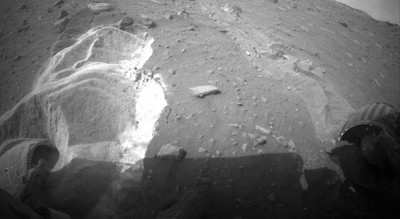Evidence Suggests Conditions Are Similar To The Mojave
Desert
NASA scientists are seeing new evidence that suggests traces of
water on Mars are under a thin varnish of iron oxide, or rust,
similar to conditions found on desert rocks in California's Mojave
Desert.

Mars could be spotted with many more patches of carbonates than
originally suspected. Carbonates are minerals that form readily in
large bodies of water and can point to a planet's wet history.
Although only a few small outcrops of carbonates have been detected
on Mars, scientists believe many more examples are blocked from
view by the rust. The findings appeared in the Friday July 1,
online edition of the International Journal of Astrobiology.
"The plausibility of life on Mars depends on whether liquid
water dotted its landscape for thousands or millions of years,"
said Janice Bishop, a planetary scientist at NASA's Ames Research
Center at the SETI Institute at Moffett Field, CA, and the paper's
lead author. "It's possible that an important clue, the presence of
carbonates, has largely escaped the notice of investigators trying
to learn if liquid water once pooled on the Red Planet."
Scientists conduct field experiments in desert regions because
the extremely dry conditions are similar to Mars. Researchers
realized the importance of the varnish earlier this year when
Bishop and Chris McKay, a planetary scientist at Ames investigated
carbonate rocks coated with iron oxides collected in a location
called Little Red Hill in the Mojave Desert. "When we examined the
carbonate rocks in the lab, it became evident that an iron oxide
skin may be hindering the search for clues to the Red Planet's
hydrological history," McKay said. "We found that the varnish both
altered and partially masked the spectral signature of the
carbonates."

NASA Mars Recon Orbiter (MRO)
McKay also found dehydration-resistant blue-green algae under
the rock varnish. Scientists believe the varnish may have extended
temporarily the time that Mars was habitable, as the planet's
surface slowly dried up. "The organisms in the Mojave Desert are
protected from deadly ultraviolet light by the iron oxide coating,"
McKay said. "This survival mechanism might have played a role if
Mars once had life on the surface."
In addition to being used to help characterize Mars' water
history, carbonate rocks also could be a good place to look for the
signatures of early life on the Red Planet. Every mineral is made
up of atoms that vibrate at specific frequencies to produce a
unique fingerprint that allows scientists to accurately identify
its composition.
Research data were similar to observations provided by NASA's
Mars Reconnaissance Orbiter (MRO) spacecraft, as it orbited an
ancient region of Mars called Nili Fossae. The area revealed the
strongest carbonate signature ever found. Although MRO recently
detected small patches of carbonates, approximately 200-500 feet
wide, on the Martian surface, the Mojave study suggests more
patches may have been overlooked because their spectral signature
could have been changed by the pervasive varnish. "To better
determine the extent of carbonate deposits on Mars, and by
inference the ancient abundance of liquid water, we need to
investigate the spectral properties of carbonates mixed with other
minerals," Bishop said.

NASA Image From Mars Rover Spirit
The varnish is so widespread that NASA's Mars Exploration
Rovers, Spirit and Opportunity, used a motorized grinding tool to
remove the rust-like overcoat on rocks before other instruments
could inspect them. In 2010, scientists using data collected by
Spirit also identified a small carbonate outcrop at a crater called
Gusev. NASA's newest and most capable rover, the Mars Science
Laboratory Curiosity is schedule to launch in November. It will use
tools to study whether the Mars had environmental conditions
favorable for supporting microbial life and favorable for
preserving clues about whether life existed.
 ANN's Daily Aero-Term (04.30.24): Runway Centerline Lighting
ANN's Daily Aero-Term (04.30.24): Runway Centerline Lighting ANN's Daily Aero-Linx (04.30.24)
ANN's Daily Aero-Linx (04.30.24) Airborne 04.24.24: INTEGRAL E, Elixir USA, M700 RVSM
Airborne 04.24.24: INTEGRAL E, Elixir USA, M700 RVSM Airborne 04.29.24: EAA B-25 Rides, Textron 2024, G700 Deliveries
Airborne 04.29.24: EAA B-25 Rides, Textron 2024, G700 Deliveries Airborne-NextGen 04.23.24: UAVOS UVH 170, magni650 Engine, World eVTOL Directory
Airborne-NextGen 04.23.24: UAVOS UVH 170, magni650 Engine, World eVTOL Directory





